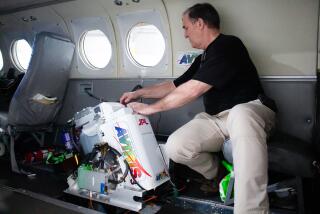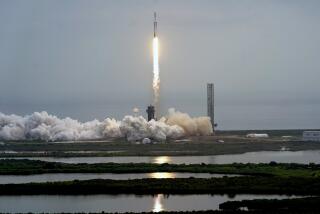NASA launches new mapping spacecraft
- Share via
NASA’s newest mapping mission, designed to sniff out the dimmest residents of our neighborhood in space, launched successfully this morning from Vandenberg Air Force Base in California.
The Delta II rocket carrying the Wide-Field Infrared Survey Explorer spacecraft lifted off at 6:09 a.m., Pacific time.
About eight minutes later, the 1,485-pound WISE craft entered space. About 52 minutes into the flight, the craft’s second-stage rocket ignited again, placing the vehicle into its assigned polar orbit 326 miles above the Earth.
Over the next 10 months, the spacecraft will photograph the entire night sky in the infrared region of the electromagnetic spectrum, finding objects too dim and cool to appear in ordinary light, much as night goggles reveal the faint signatures of warm-blooded creatures that would otherwise be hidden by vegetation or darkness.
The craft should greatly expand the catalogue of the known universe. In our solar neighborhood alone, it is expected to find thousands of never-seen asteroids between Mars and Jupiter, along with dozens of failed stars -- objects known as brown dwarfs, which weren’t massive enough to become full-blown stars -- farther out in space. One or more of these brown dwarfs could be closer than our nearest stellar neighbor, Proxima Centauri, four light years away.
Some astronomers think the craft even could find a new planet lurking out beyond Pluto in the largely unknown area of comets and small, icy bodies known as the Kuiper Belt.
To achieve this, the spacecraft carries a 16-inch-diameter telescope and a set of detectors encased in 35 pounds of frozen hydrogen known as a cryostat. This ice bucket will chill the instruments to -429 degrees to prevent the four detectors, each of which utilizes 1-million pixels to scan the universe, from picking up heat from WISE’s own systems.
NASA’s first attempt to map the infrared sky was in 1983, when it launched the Infrared Astronomical Satellite, known as IRAS. That craft had a resolution of just 62 pixels, but even so, it found hundreds of thousands of never-before-glimpsed objects in space. With its vastly superior suite of instruments, WISE is expected to make a much more detailed map.
WISE is not the only infrared mission in operation. The Spitzer space telescope was launched by NASA in 2003. In May of this year, the Herschel Space Observatory, a joint project between NASA and Europe, was sent into orbit. But both of those spacecraft target very specific regions of the sky, while WISE will look at everything, including distant galaxies. The difference is similar to the disparity between a telephoto camera lens and a wide-angle lens.
The $320-million WISE mission is designed to last until the frozen hydrogen warms up, or about 10 months. During that time, the spacecraft will photograph the entire sky 1 1/2 times.
More to Read
Sign up for Essential California
The most important California stories and recommendations in your inbox every morning.
You may occasionally receive promotional content from the Los Angeles Times.










